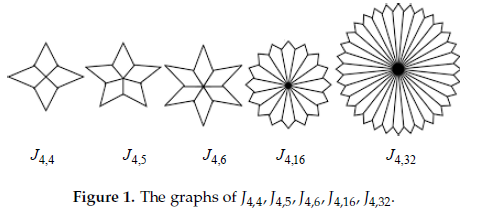Topological indices are numerical numbers associated with a graph that helps to predict many properties of underlined graph. In this paper we aim to compute multiplicative degree based topological indices of Jahangir graph.
The study of topological indices, based on distance in a graph, was effectively employed in 1947, in chemistry by Weiner [1]. He introduced a distance-based topological index called the Wiener index to correlate properties of alkenes and the structures of their molecular graphs.
Topological indices play a vital role in computational and theoretical aspects of chemistry in predicting material properties [2, 3, 4, 5, 6, 7, 8]. Several algebraic polynomials have useful applications in chemistry [9, 10]. A graph \(G\) is an ordered pair \((V,E)\), where \(V\) is the set of vertices and \(E\) is the set of edges. A path from a vertex \(v\) to a vertex \(w\) is a sequence of vertices and edges that starts from \(v\) and stops at \(w\). The number of edges in a path is called the length of that path.
A graph is said to be connected if there is a path between any two of its vertices. The distance \(d(u,v)\) between two vertices \(u\), \(v\) of a connected graph \(G\) is the length of a shortest path between them. Graph theory is contributing a lion’s share in many areas such as chemistry, physics, pharmacy, as well as in industry [11]. We will start with some preliminary facts.
The first and second multiplicative Zagreb indices [12] are defined as \begin{equation} MZ_{1}(G)=\prod\limits_{u\in V(G)}(d_{u})^{2}, \end{equation} \begin{equation} MZ_{2}(G)=\prod\limits_{uv\in E(G)}d_{u}. d_{u}, \end{equation} and the Narumi-Kataymana index [13] is defined as \begin{equation} NK(G)=\prod\limits_{u\in V(G)}d_{u}, \end{equation} Like the Wiener index, these types of indices are the focus of considerable research in computational chemistry [14, 15, 16, 17]. For example, in 2011, Gutman [14] characterized the multiplicative Zagreb indices for trees and determined the unique trees that obtained maximum and minimum values for \(M_{1}(G)\) and \(M_{2}(G)\). Wang et al. [17] define the following index for k-trees, \begin{equation} W^{s}_{1}(G)=\prod\limits_{u\in V(G)}(d_{u})^{s}. \end{equation} Notice that \(s=1,2\) is the Narumi-Katayama and Zagreb index, respectively. Based on the successful consideration of multiplicative Zagreb indices, Eliasi et al. [18] continued to define a new multiplicative version of the first Zagreb index as \begin{equation} MZ^{\ast}_{1}(G)=\prod\limits_{uv\in E(G)}(d_{u}+d_{u}), \end{equation} Furthering the concept of indexing with the edge set, the first author introduced the first and second hyper-Zagreb indices of a graph [19]. They are defined as \begin{equation} HII_{1}(G)=\prod\limits_{uv\in E(G)}(d_{u}+d_{u})^{2}, \end{equation} \begin{equation} HII_{2}(G)=\prod\limits_{uv\in E(G)}(d_{u}.d_{u})^{2}, \end{equation} In [20] Kulli et al. defined the first and second generalized Zagreb indices \begin{equation} MZ^{a}_{1}(G)=\prod\limits_{uv\in E(G)}(d_{u}+d_{u})^{a}, \end{equation} \begin{equation} MZ^{a}_{2}(G)=\prod\limits_{uv\in E(G)}(d_{u}.d_{u})^{a}, \end{equation} Multiplicative sum connectivity and multiplicative product connectivity indices [21] are define as: \begin{equation} SCII(G)=\prod\limits_{uv\in E(G)}\frac{1}{(d_{u}+d_{u})}, \end{equation} \begin{equation} PCII(G)(G)=\prod\limits_{uv\in E(G)}\frac{1}{(d_{u}.d_{u})}, \end{equation} Multiplicative atomic bond connectivity index and multiplicative Geometric arithmetic index are defined as \begin{equation} ABCII(G)=\prod\limits_{uv\in E(G)}\sqrt{\frac{d_{u}+d_{u}-2}{d_{u}.d_{u}}}, \end{equation} \begin{equation} GAII(G)=\prod\limits_{uv\in E(G)}\frac{2\sqrt{d_{u}.d_{u}}}{d_{u}+d_{u}}, \end{equation} \begin{equation} GA^{a}II(G)=\prod\limits_{uv\in E(G)}\left(\frac{2\sqrt{d_{u}.d_{u}}}{d_{u}+d_{u}}\right)^{a} \end{equation} In this paper we compute multiplicative indices of Jahangir graphs. The Jahangir graph \(J_{m,n}\) is a graph on \(nm + 1\) vertices and \(m(n + 1)\) edges for all \(n\geq 2\) and \(m\geq 3\). \(J_{m,n}\) consists of a cycle \(C_{mn}\) with one additional vertex which is adjacent to \(m\) vertices of \(C_{nm}\) at distance to each other. Figure 1 shows some particular cases of \(J_{m,n}\).
Theorem 2.1. Let \(J_{m,n}\) be the jahangir’s graph. Then
Proof. Let \(G\) be the graph of \(J_{m,n}\). It is clear that the total number of vertices in \(J_{m,n}\) are \(8n+2\) and total number of edges are \(10n+1\) The edge set of \(J_{m,n}\) has following three partitions, $$E_{1}=E_{2,2}=\{e=uv\in E(J_{m,n}): d_{u}=2, d_{v}=2\},$$ $$E_{1}=E_{2,3}=\{e=uv\in E(J_{m,n}): d_{u}=2, d_{v}=3\},$$ and $$E_{1}=E_{3,m}=\{e=uv\in E(J_{m,n}): d_{u}=3, d_{v}=m\}.$$ Now, $$\mid E_{1}(J_{m,n})\mid=m(n-2),$$ $$\mid E_{2}(J_{m,n})\mid=2m,$$ and $$\mid E_{1}(J_{m,n})\mid=m.$$
Corollary 2.2. Let \(J_{m,n}\) be the Jahangir’s graph. Then
Proof. We get our result by putting \(\alpha=1\) in the Theorem 2.1.
Corollary 2.3. Let \(J_{m,n}\) be the Jahangir’s graph. Then
Proof. We get our desired results by putting \(\alpha=2\) in Theorem 2.1.
Corollary 2.4. Let \(J_{m,n}\) be the Jahangir’s graph. Then
Proof. We get our desired results by putting \(\alpha=\frac{-1}{2}\) in Theorem 2.1.
Theorem 2.5. Let \(J_{m,n}\) be the Jahangir’s graph. Then $$ABCII(J_{m,n})=\left(\frac{1}{\sqrt{2}}\right)^{mn}\times \left(\sqrt{\frac{m+1}{3m}}\right)^{mn}.$$
Proof. By using the edge partition of Jahangir’s graph given in Theorem 2.1. \begin{eqnarray*} ABCII(J_{m,n})&=&\prod\limits_{uv\in E(J_{m,n})}\sqrt{\frac{d_{u}+d_{u}-2}{d_{u}.d_{u}}}\\ &=&\prod\limits_{uv\in E_{1}(J_{m,n})}\sqrt{\frac{d_{u}+d_{u}-2}{d_{u}.d_{u}}}\times \prod\limits_{uv\in E_{2}(J_{m,n})}\sqrt{\frac{d_{u}+d_{u}-2}{d_{u}.d_{u}}}\\ &&\times \prod\limits_{uv\in E_{3}(J_{m,n})}\sqrt{\frac{d_{u}+d_{u}-2}{d_{u}.d_{u}}}\\ &=&\left(\sqrt{\frac{d_{u}+d_{u}-2}{d_{u}.d_{u}}}\right)^{|E_{1}(J_{m,n})|}\times \left(\sqrt{\frac{d_{u}+d_{u}-2}{d_{u}.d_{u}}}\right)^{|E_{2}(J_{m,n})|}\\ &&\times \left(\sqrt{\frac{d_{u}+d_{u}-2}{d_{u}.d_{u}}}\right)^{|E_{3}(J_{m,n})|}\\ &=&\left(\sqrt{\frac{d_{u}+d_{u}-2}{d_{u}.d_{u}}}\right)^{m(n-2)}\times \left(\sqrt{\frac{d_{u}+d_{u}-2}{d_{u}.d_{u}}}\right)^{2m}\\ &&\times \left(\sqrt{\frac{d_{u}+d_{u}-2}{d_{u}.d_{u}}}\right)^{m}\\ &=&\left(\sqrt{\frac{1}{2}}\right)^{m(n-2)}\times \left(\sqrt{\frac{1}{2}}\right)^{2m}\times \left(\sqrt{\frac{m+1}{3m}}\right)^{mn} \\ &=& \left(\frac{1}{\sqrt{2}}\right)^{mn}\times \left(\sqrt{\frac{m+1}{3m}}\right)^{mn} \end{eqnarray*}
